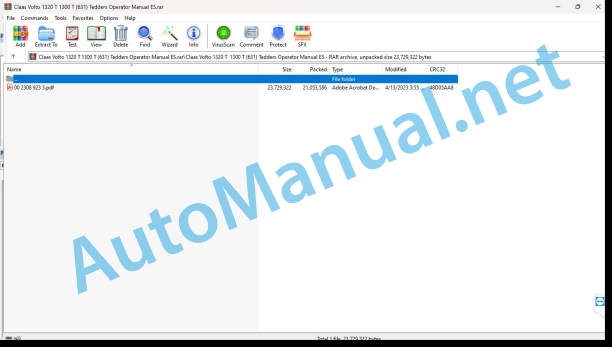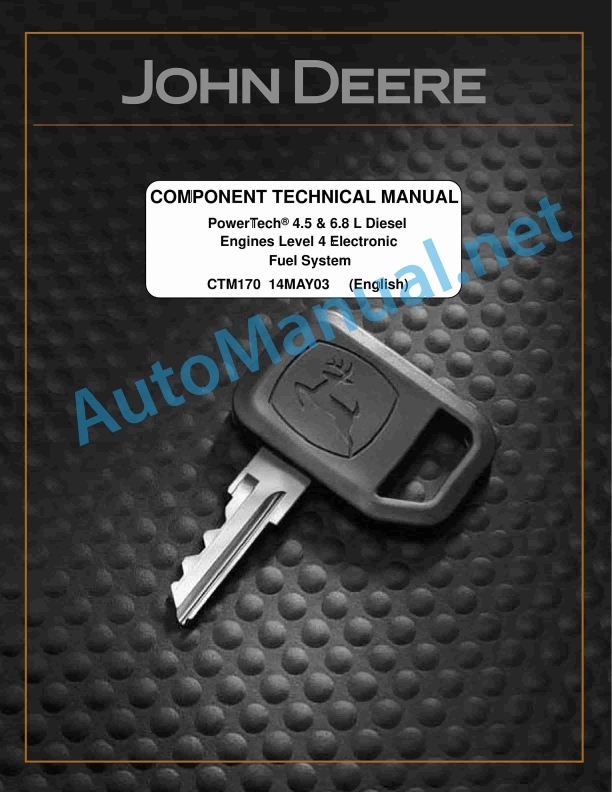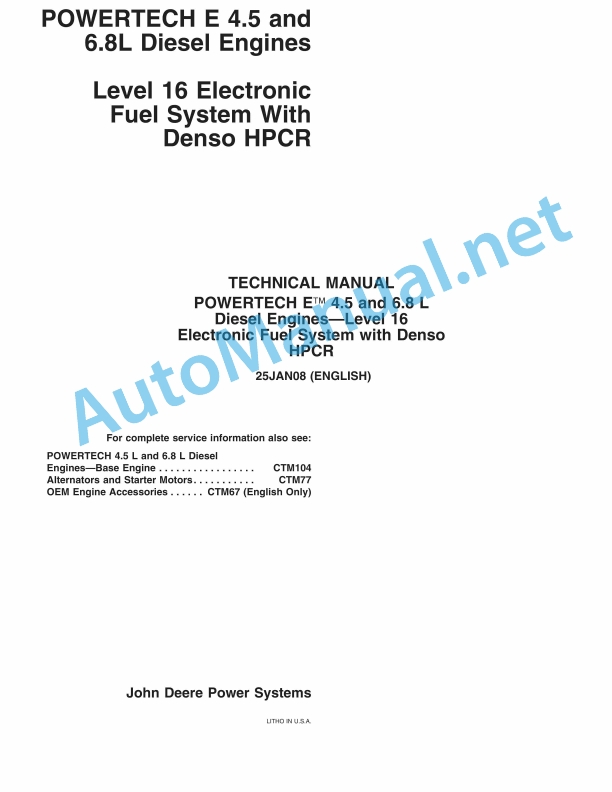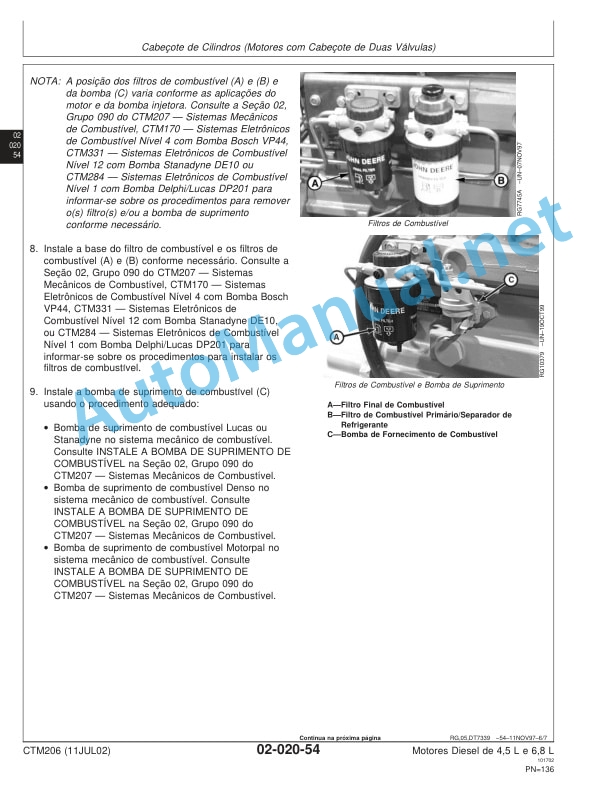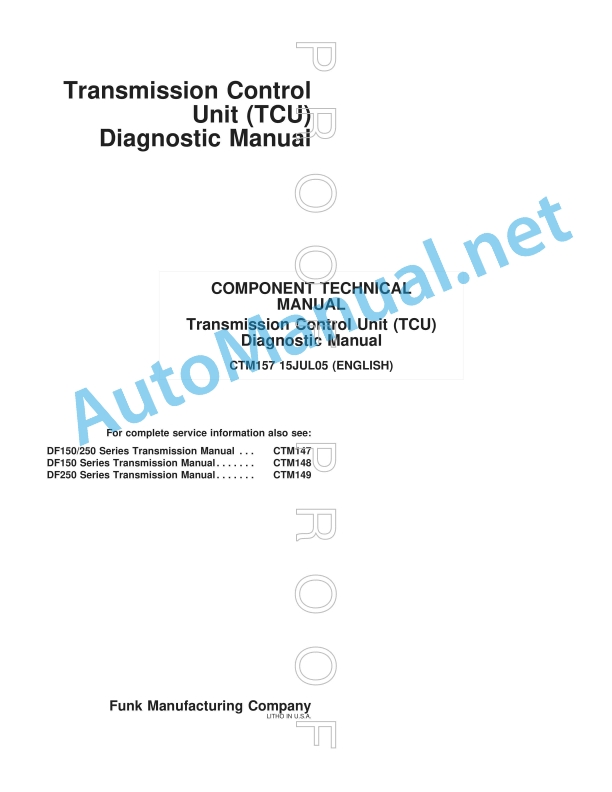Claas Volto 1320 T 1300 T (631) Tedders Operator Manual ES
$50.00
- Model: Volto 1320 T 1300 T (631) Tedders
- Type Of Manual: Operator Manual
- Language: ES
- Format: PDF(s)
- Size: 20.1 MB
File List:
00 2308 923 3.pdf
00 2308 923 3.pdf:
VOLTO 1300 T
1. Introduction
1.1 Information regarding the instruction manual
1.1.1 Validity of the manual
1.1.2 Information relating to this instruction manual
1.1.3 Symbols and indications
1.1.4 Optional equipment
1.1.5 Qualified specialized workshop
1.1.6 Maintenance instructions
1.1.7 Information regarding warranty
1.1.8 Spare parts and technical issues
1.2 Proper application of the machine
1.2.1 Proper machine application
1.2.2 Logically foreseeable inappropriate application
2 Security
2.1 Recognize warning signs
2.1.1 Danger symbols
2.1.2 Keyword
2.2 Safety instructions
2.2.1 Meaning of the instruction manual
2.2.2 Observe graphic danger symbols and alarm indications
2.2.3 Requirements for all people working with the machine
2.2.4 Children in danger
2.2.5 Danger zones
2.2.6 Position yourself between the tractor and the machine
2.2.7 Accompanying persons
2.2.8 Couple the tractor with the machine
2.2.9 Risk of injury due to rotating shafts
2.2.10 Construction modifications
2.2.11 Optional equipment and spare parts
2.2.12 Control of the machine in operation
2.2.13 Use only after correct start-up
2.2.14 Technical status
2.2.15 Danger due to machine breakdowns
2.2.16 Comply with technical limit values
2.2.17 Danger due to coasting parts
2.2.18 Maintain functional protection devices
2.2.19 Personal protective equipment
2.2.20 Wear appropriate clothing
2.2.21 Remove dirt and loose objects
2.2.22 Prepare the machine for road traffic
2.2.23 Dangers when driving on the road and in the countryside
2.2.24 Park the machine safely
2.2.25 Parking without supervision
2.2.26 Unsuitable consumables
2.2.27 Safe handling of consumables and auxiliary materials
2.2.28 Environmental protection and waste disposal
2.2.29 Fire protection
2.2.30 Deadly electrical discharge through overhead lines
2.2.31 Liquids under pressure
2.2.32 Hot surfaces
2.2.33 Work only on the stopped machine
2.2.34 Maintenance work and repair work
2.2.35 Machine parts and lifted loads
2.2.36 Danger from welding work
2.3 Safety instructions on the machine
2.3.1 Structure of graphic hazard symbols
2.3.2 Position of warning symbols on the machine
3 Machine Description
3.1 Summary and operation
3.1.1 Machine overview
3.1.2 Machine operating mode
3.2 Optional equipment
3.2.1 Freewheeling wide-angle double cardan shaft, 6 pieces*
3.2.2 Cardan shaft without freewheel, 6 pieces*
3.2.3 Free-running wide-angle double cardan shaft, 21 pieces*
3.2.4 Union fork kit*
3.2.5 Hydraulic connection parts 2 pieces*
3.2.6 US lighting adapter*
3.2.7 Anti-loss safety for tines ø 9.5 mm*
3.2.8 Anti-loss safety for tines ø 10.5 mm*
3.2.9 Hydraulic limiting canvas*
3.2.10 Spare wheel 16×6.5-8*
3.2.11 Spare wheel 18.5×8.8 3.2.12 Anti-winding plates*
3.2.13 Legal technical equipment of the European Union*
3.2.14 SMV Triangle*
3.2.15 Elevation at the headboards*
3.2.16 Side marker lights*
3.2.17 Drainers*
3.3 Identification plates and vehicle identification number
3.3.1 Machine identification plate
3.3.2 Machine identification plate
3.4 Machine information
3.4.1 Adhesive on the machine
4 Control and display instruments
4.1 Control elements
4.1.1 Hydraulic hose
4.1.2 Feeler wheels
5 Technical data
5.1 VOLT 1300 T
5.1.1 Dimensions
5.1.2 Weights
5.1.3 Tractor requirements
5.1.4 Electrical installation
5.1.5 Version
5.1.6 Tire measurements
5.1.7 Tire pressure
5.1.8 Acoustic intensity level
5.1.9 Lubricants
6 Preparation of the machine
6.1 Turn off the machine and secure it
6.1.1 Shut down and secure the machine and tractor
6.1.2 Secure the lifted machine
6.2 Prepare the tractor
6.2.1 Check the tractor power take-off protection device
6.3 Adapt the machine
6.3.1 Check the length of the cardan shaft
Shortest working position of the cardan shaft
Longest working position of the cardan shaft
6.3.2 Adapt the length of the cardan shaft
6.3.3 Assemble the cardan shaft to the machine
6.4 Hooking up the machine
6.4.1 Remove the security lock*
6.4.2 Attach the hitch bracket
6.4.3 Assemble the cardan shaft
6.4.4 Attach the safety chain*
6.4.5 Plug in the lighting cable
6.4.6 Attach the hydraulic hoses
6.4.7 Attach the hydraulic hose for the limitation canvas*
6.4.8 Attach the hydraulic hose for lifting at headlands*
6.4.9 Save shims
6.5 Unhooking the machine
6.5.1 Put the shims underneath
6.5.2 Remove the lighting cable
6.5.3 Disconnect the hydraulic hose
6.5.4 Detach the hydraulic hose for the limitation canvas*
6.5.5 Disconnect the hydraulic hose for lifting at headlands*
6.5.6 Dismantle the cardan shaft
6.5.7 Unhooking the safety chain*
6.5.8 Unhook the coupling bracket
6.5.9 Engage the safety lock*
6.6 Prepare for road traffic
6.6.1 Folding the hydraulic limiting canvas*
6.6.2 Fold the machine into transport position
6.6.3 Close the stopcock
6.6.4 Check before driving on the road
6.7 Prepare the working position
6.7.1 Open the stopcock
6.7.2 Deploy the machine to the working position
6.7.3 Deploy the hydraulic limitation canvas*
6.8 Load the machine
6.8.1 Lift the machine
7 Management
7.1 Driving on the road
7.1.1 Circulation on public roads
7.2 Settings for use at work
7.2.1 Adjust the spreading angle
7.2.2 Adjust the spreading angle 16°
7.2.3 Adjust the spreading angle 16°
7.2.4 Adjust the spreading angle 12°
7.2.5 Adjust the spreading angle 12°
7.2.6 Adjust spreading
7.2.7 Adjust the tines
7.2.8 Adjust the working height
7.2.9 Adjust the hydraulic limiting canvas*
7.2.10 Eliminate winding problems on wheel axles
7.3 Use at work
7.3.1 Take into act dg the field trip
7.3.2 Spread
7.3.3 Flipping
7.3.4 Row spreading
7.3.5 Night rows
7.3.6 Row turning
7.3.7 Turning with limiting canvas*
7.3.8 Difficult harvest conditions
7.3.9 Manage headland elevation*
7.3.10 In tight curves and when moving in reverse, raise the machine
8 Incident and solution
8.1 Summary of incidents
8.1.1 Incidents on the machine
8.2 Chassis
8.2.1 Change the wheel on the transport chassis
8.2.2 Change wheel on the rotor chassis
8.2.3 Change the feeler wheel
8.2.4 Adjust the feeler wheels
8.3 Hydraulic installation
8.3.1 The folding process is interrupted in transport position
8.3.2 The chassis does not lower when folding to the transport position
8.3.3 The machine does not lower when unfolded to the working position
8.3.4 Check the headland lift valve*
8.3.5 Rotor arms do not rotate
8.4 Electrical and electronic system
8.4.1 Faulty lighting
8.5 Assembled parts and machine casing
8.5.1 The outgoing arm is insufficiently supported
9 Maintenance
9.1 Summary of maintenance intervals
9.1.1 Before harvest
9.1.2 After the first 10 hours of service
9.1.3 After the first 50 hours of service
9.1.4 Every 8 hours of service or daily
9.1.5 Every 20 hours of service
9.1.6 Every 50 hours of service
9.1.7 Every 500 hours of service or annually
9.1.8 Every 5 years
9.1.9 After harvest
9.2 Gearbox
9.2.1 Check the tightness of the gear
9.2.2 Check the main gear oil level
9.2.3 Change main gear oil
9.2.4 Rotor gear maintenance
9.3 Clutches
9.3.1 Check the overload clutch
9.3.2 Clean the cardan shaft locking clutch
9.4 Cardan shaft
9.4.1 Maintenance of cardan shafts
9.4.2 Remove the cardan shaft protection
9.4.3 Install the cardan shaft protection
9.5 Chassis
9.5.1 Check tire pressure
9.5.2 Check the wheel nuts on the transport chassis
9.5.3 Check the wheel nuts on the rotor chassis
9.5.4 Check the feeler wheel axle nuts
9.6 Hydraulic installation
9.6.1 Check the hydraulic hoses
9.6.2 Check the pressure accumulator
9.6.3 Check the hydraulic cylinder of the outer arms
9.6.4 Check the hydraulic cylinder of the longitudinal support
9.6.5 Check the hydraulic cylinder of the transport chassis
9.7 Pick holder
9.7.1 Check the tines
9.8 Assembled parts and machine casing
9.8.1 Eliminate crop remains
9.8.2 Clean the machine
9.8.3 Maintain the machine
9.8.4 Check the fixing material
9.8.5 Check the screwed joints on the chassis
9.8.6 Check the outer arm rods
9.9 Greasing scheme
9.9.1 Grease the lubrication points every 8 hours of service
9.9.2 Grease the lubrication points every 20 hours of service
9.9.3 Grease the lubrication points every 50 hours of service
10 Decommissioning and waste disposal
10.1 General information
10.1.1 Decommissioning and waste disposal
11 Declaration of conformity
11.1 VOLT 1300 T
11.1.1 EC declaration of conformity
12 Technical dictionary and abbreviations
12.1 Terms and explanations
12.1.1 Technicalities
12.1.2 Abbreviations
John Deere Repair Technical Manual PDF
John Deere DF Series 150 and 250 Transmissions (ANALOG) Component Technical Manual CTM147 05JUN98
John Deere Repair Technical Manual PDF
John Deere Repair Technical Manual PDF
John Deere Repair Technical Manual PDF
John Deere POWERTECH E 4.5 and 6.8 L Diesel Engines TECHNICAL MANUAL 25JAN08
John Deere Repair Technical Manual PDF
John Deere Repair Technical Manual PDF
John Deere Repair Technical Manual PDF
John Deere Transmission Control Unit Component Technical Manual CTM157 15JUL05
John Deere Repair Technical Manual PDF
John Deere Repair Technical Manual PDF
John Deere Diesel Engines PowerTech 4.5L and 6.8L – Motor Base Technical Manual 07MAY08 Portuguese

